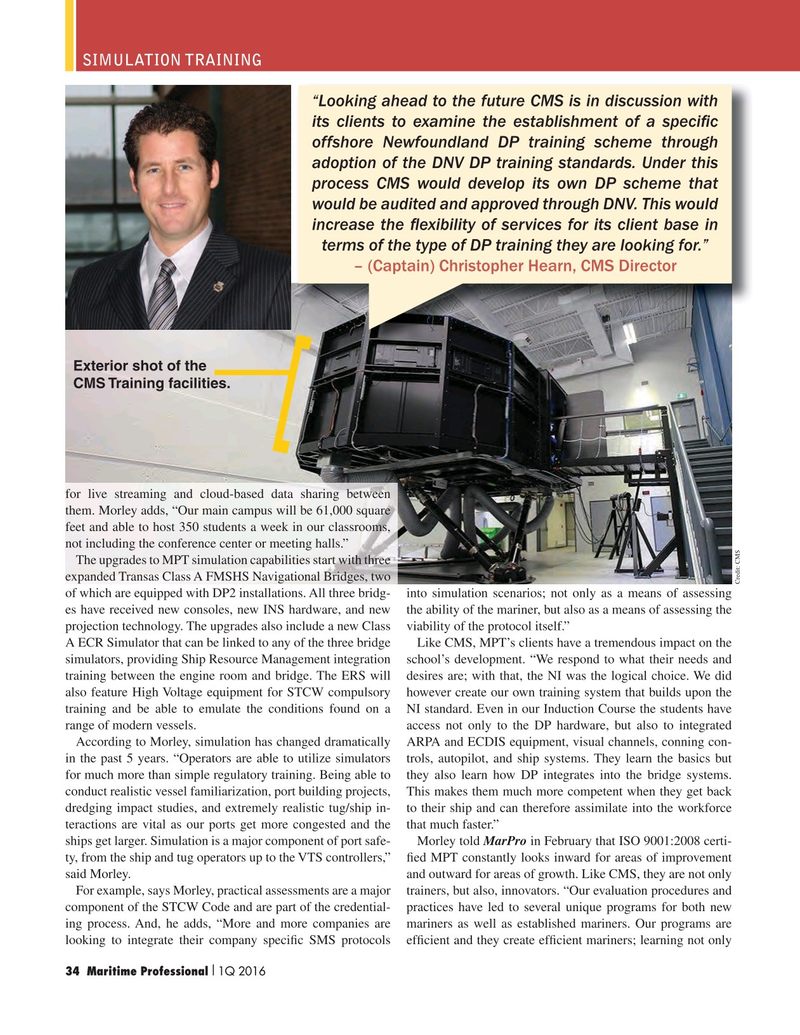
Page 34: of Maritime Logistics Professional Magazine (Q1 2016)
Maritime Training and Education
Read this page in Pdf, Flash or Html5 edition of Q1 2016 Maritime Logistics Professional Magazine
SIMULATION TRAINING “Looking ahead to the future CMS is in discussion with its clients to examine the establishment of a speci? c offshore Newfoundland DP training scheme through adoption of the DNV DP training standards. Under this process CMS would develop its own DP scheme that would be audited and approved through DNV. This would increase the ? exibility of services for its client base in terms of the type of DP training they are looking for.” – (Captain) Christopher Hearn, CMS Director
Exterior shot of the
CMS Training facilities.
for live streaming and cloud-based data sharing between them. Morley adds, “Our main campus will be 61,000 square feet and able to host 350 students a week in our classrooms, not including the conference center or meeting halls.”
The upgrades to MPT simulation capabilities start with three expanded Transas Class A FMSHS Navigational Bridges, two
Credit: CMS of which are equipped with DP2 installations. All three bridg- into simulation scenarios; not only as a means of assessing es have received new consoles, new INS hardware, and new the ability of the mariner, but also as a means of assessing the projection technology. The upgrades also include a new Class viability of the protocol itself.”
A ECR Simulator that can be linked to any of the three bridge Like CMS, MPT’s clients have a tremendous impact on the simulators, providing Ship Resource Management integration school’s development. “We respond to what their needs and training between the engine room and bridge. The ERS will desires are; with that, the NI was the logical choice. We did also feature High Voltage equipment for STCW compulsory however create our own training system that builds upon the training and be able to emulate the conditions found on a NI standard. Even in our Induction Course the students have range of modern vessels. access not only to the DP hardware, but also to integrated
According to Morley, simulation has changed dramatically ARPA and ECDIS equipment, visual channels, conning con- in the past 5 years. “Operators are able to utilize simulators trols, autopilot, and ship systems. They learn the basics but for much more than simple regulatory training. Being able to they also learn how DP integrates into the bridge systems. conduct realistic vessel familiarization, port building projects, This makes them much more competent when they get back dredging impact studies, and extremely realistic tug/ship in- to their ship and can therefore assimilate into the workforce teractions are vital as our ports get more congested and the that much faster.” ships get larger. Simulation is a major component of port safe- Morley told MarPro in February that ISO 9001:2008 certi- ty, from the ship and tug operators up to the VTS controllers,” ? ed MPT constantly looks inward for areas of improvement said Morley. and outward for areas of growth. Like CMS, they are not only
For example, says Morley, practical assessments are a major trainers, but also, innovators. “Our evaluation procedures and component of the STCW Code and are part of the credential- practices have led to several unique programs for both new ing process. And, he adds, “More and more companies are mariners as well as established mariners. Our programs are looking to integrate their company speci? c SMS protocols ef? cient and they create ef? cient mariners; learning not only
I 34 Maritime Professional 1Q 2016 34-49 Q1 MP2016.indd 34 2/29/2016 11:06:24 AM

 33
33

 35
35
